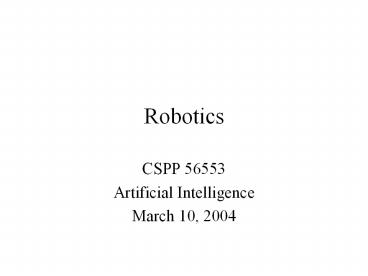Robotics - PowerPoint PPT Presentation
Title:
Robotics
Description:
Distance to objects range finding/sonar/GPS. Recognize ... Retract, lift. higher. no. yes. Set. Down. Emergent Behavior. Reactive controller walks robustly ... – PowerPoint PPT presentation
Number of Views:26
Avg rating:3.0/5.0
Title: Robotics
1
Robotics
- CSPP 56553
- Artificial Intelligence
- March 10, 2004
2
Roadmap
- Robotics is AI-complete
- Integration of many AI techniques
- Classic AI
- Search in configuration space
- (Ultra) Modern AI
- Subsumption architecture
- Multi-level control
- Conclusion
3
Mobile Robots
4
Robotics is AI-complete
- Robotics integrates many AI tasks
- Perception
- Vision, sound, haptics
- Reasoning
- Search, route planning, action planning
- Learning
- Recognition of objects/locations
- Exploration
5
Sensors and Effectors
- Robotics interact with real world
- Need direct sensing for
- Distance to objects range finding/sonar/GPS
- Recognize objects vision
- Self-sensing proprioception pose/position
- Need effectors to
- Move self in world locomotion wheels, legs
- Move other things in world manipulators
- Joints, arms Complex many degrees of freedom
6
Real World Complexity
- Real world is hardest environment
- Partially observable, multiagent, stochastic
- Problems
- Localization and mapping
- Where things are
- What routes are possible
- Where robot is
- Sensors may be noisy Effectors are imperfect
- Dont necessarily go where intend
- Solved in probabilistic framework
7
Navigation
8
Application Configuration Space
- Problem Robot navigation
- Move robot between two objects without changing
orientation - Possible?
- Complex search space boundary tests, etc
9
Configuration Space
- Basic problem infinite states! Convert to finite
state space. - Cell decomposition
- divide up space into simple cells, each of which
can be traversed easily" (e.g., convex) - Skeletonization
- Identify finite number of easily connected
points/lines that form a graph such that any two
points are connected by a path on the graph
10
Skeletonization Example
- First step Problem transformation
- Model robot as point
- Model obstacles by combining their perimeter
path of robot around it - Configuration Space simpler search
11
Navigation
12
Navigation
13
Navigation as Simple Search
- Replace funny robot shape in field of funny
shaped obstacles with - Point robot in field of configuration shapes
- All movement is
- Start to vertex, vertex to vertex, or vertex to
goal - Search Start, vertices, goal, connections
- A search yields efficient least cost path
14
Online Search
- Offline search
- Think a lot, then act once
- Online search
- Think a little, act, look, think,..
- Necessary for exploration, (semi)dynamic env
- Components Actions, step-cost, goal test
- Compare cost to optimal if env known
- Competitive ratio (possibly infinite)
15
Online Search Agents
- Exploration
- Perform action in state -gt record result
- Search locally
- Why? DFS? BFS?
- Backtracking requires reversibility
- Strategy Hill-climb
- Use memory if stuck, try apparent best neighbor
- Unexplored state assume closest
- Encourages exploration
16
Acting without Modeling
- Goal Move through terrain
- Problem I Dont know what terrain is like
- No model!
- E.g. rover on Mars
- Problem II Motion planning is complex
- Too hard to model
- Solution Reactive control
17
Reactive Control Example
- Hexapod robot in rough terrain
- Sensors inadequate for full path planning
- 2 DOF6 legs kinematics, plan intractable
18
Model-free Direct Control
- No environmental model
- Control law
- Each leg cycles on ground in air
- Coordinate so that 3 legs on ground (opposing)
- Retain balance
- Simple, works on flat terrain
19
Handling Rugged Terrain
- Problem Obstacles
- Block legs forward motion
- Solution Add control rule
- If blocked, lift higher and repeat
- Implementable as FSM
- Reflex agent with state
20
FSM Reflex Controller
Retract, lift higher
yes
no
S3
Stuck?
S4
Move Forward
Set Down
Lift up
S2
S1
Push back
21
Emergent Behavior
- Reactive controller walks robustly
- Model-free no search/planning
- Depends on feedback from the environment
- Behavior emerges from interaction
- Simple software complex environment
- Controller can be learned
- Reinforcement learning
22
Subsumption Architecture
- Assembles reactive controllers from FSMs
- Test and condition on sensor variables
- Arcs tagged with messages sent when traversed
- Messages go to effectors or other FSMs
- Clocks control time to traverse arc- AFSM
- E.g. previous example
- Reacts to contingencies between robot and env
- Synchronize, merge outputs from AFSMs
23
Subsumption Architecture
- Composing controllers from composition of AFSM
- Bottom up design
- Single to multiple legs, to obstacle avoidance
- Avoids complexity and brittleness
- No need to model drift, sensor error, effector
error - No need to model full motion
24
Subsumption Problems
- Relies on raw sensor data
- Sensitive to failure, limited integration
- Typically restricted to local tasks
- Hard to change task
- Emergent behavior not specified plan
- Hard to understand
- Interactions of multiple AFSMs complex
25
Solution
- Hybrid approach
- Integrates classic and modern AI
- 3 layer architecture
- Base reactive layer low-level control
- Fast sensor action loop
- Executive (glue) layer
- Sequence actions for reactive layer
- Deliberate layer
- Generates global solutions to complex tasks with
planning - Model based pre-coded and/or learned
- Slower
- Some variant appears in most modern robots
26
Conclusion
- Robotics as AI microcosm
- Back to PEAS model
- Performance measure, environment, actuators,
sensors - Robots as agents act in full complex real world
- Tasks, rely on actuators and sensing of
environment - Exploits perceptions, learning, and reasoning
- Integrates classic AI search, representation with
modern learning, robustness, real-world focus































